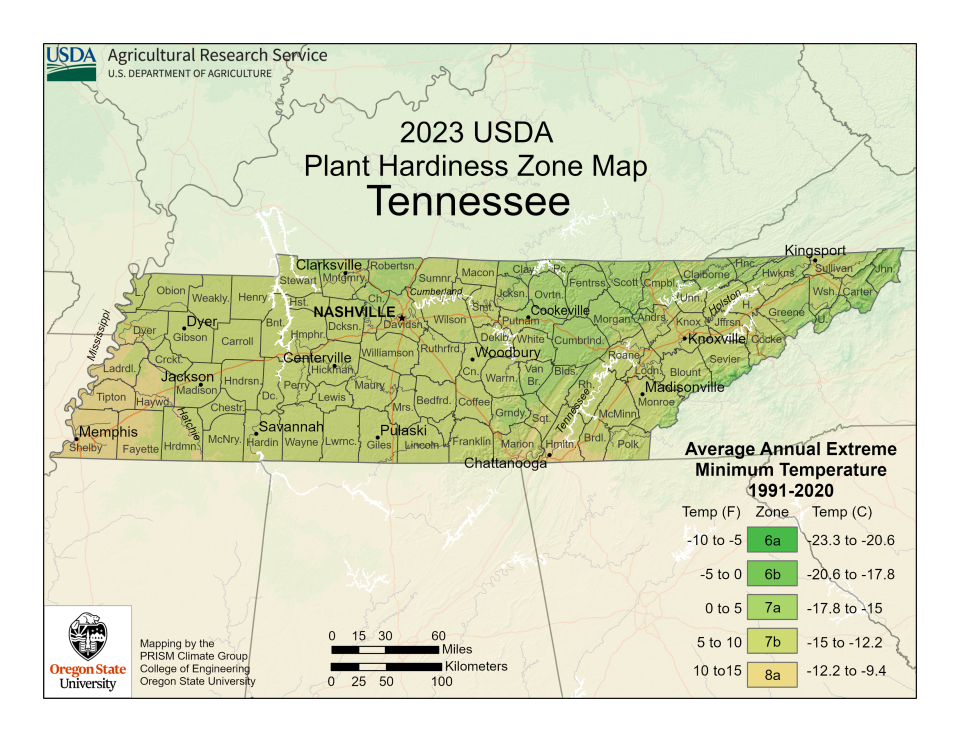What's Nashville's cold plant hardiness zone? What changes could mean for gardeners and growers.
On Nov. 15, the U.S. Department of Agriculture (USDA) released a new version of its Plant Hardiness Zone Map, the first time it's done so since 2012.
According to a release from the USDA, the new map is more accurate and contains greater detail than prior versions. The map indicates that while one half of the country remained in the same half zone, the other half shifted to the next warmer half zone, including Tennessee.
What does this change signify? And what else can the updated map tell us? Here is what we know.
What is the plant hardiness zone map?
The map is the standard by which gardeners and growers can determine which plants are most likely to thrive in a location, it is based on the average annual extreme minimum winter temperature displayed as 10-degree F zones and 5-degree F half zones.

The new map is based on 30-year averages of the lowest annual winter temperatures at specific locations, is divided into 10-degree Fahrenheit zones and further divided into 5-degree Fahrenheit half-zones. The map incorporates data from 13,412 weather stations as opposed to the 7,983 that were used for the 2012 map.
What are plant hardiness zones?
Plant hardiness zones represent what’s known as the “average annual extreme minimum temperature” at a given location during a particular time period. The designations do not reflect the coldest it has ever been or ever will be at a specific location, rather the average lowest winter temperature for the location over a specified time.
"That shift to the next warmer half zone means those areas warmed somewhere in the range of 0-5 degrees Fahrenheit; however, some locations experienced warming in the range of 0-5 degrees Fahrenheit without moving to another half zone," said the USDA.
What does the change in zone mean for Tennessee?
In the latest map, Davidson County moved from the “7a” zone to the “7b” zone, meaning a 5-degree increase in the average annual extreme minimum temperature.
According to Amy Dunlap, University of Tennessee Knoxville extension agent for the Davidson County, this won't result in much change for gardeners.
"The plants that currently perform well here will largely remain the same since we are still in zone 7," she said. "When purchasing plants they typically will be labeled for their full hardiness zone, not segmented by 7a or 7b."
According to Dunlap, Davidson County is in a transition zone between hot and cold climates. UT Western Region Horticulture Specialist, Celeste Scott, said the western and southern parts of the state will likely be the ones to start pushing boundaries on growing plants that traditionally haven't performed well, however Middle Tennessee will still be able to grow the same species as before the change.
The changes to the map won't affect the way we should care for houseplants, said Dunlap. The same guidelines will still apply in protecting them from cold temperatures.
"Houseplants need to be brought inside when temperatures are consistently dipping to 50-55 degrees F," she said. "Cold sensitive landscape plants should be protected when temperatures dip to about 32 degrees F."
What does the change mean for plants in Tennessee?
All current species of plants will be unaffected, said Dunlap. There should not be any concern about the zone switch affecting existing landscape plants.
People will still be able to grow common hydrangeas, boxwoods and azaleas.
Are the changes in zone due to climate change?
According to the USDA, the changes in the zones are not indicators of global climate change due to the highly variable nature of the extreme minimum temperature of the year, as well as the use of sophisticated mapping methods and the inclusion of data from more weather stations.
Diana Leyva covers trending news and service for The Tennessean. Contact her at Dleyva@gannett.com or follow her on X, the platform formerly known as Twitter, at @_leyvadiana
This article originally appeared on Nashville Tennessean: Nashville's Plant Hardiness Zone just changed. What growers should know

